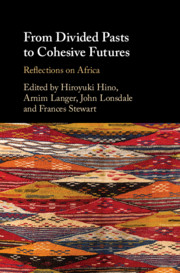Book contents
- From Divided Pasts to Cohesive Futures
- From Divided Pasts to Cohesive Futures
- Copyright page
- Contents
- Figures
- Tables
- Contributors
- Foreword
- Acknowledgments
- Introduction: Understanding Processes of Change in Social Cohesion: Learning from Comparative History
- Part I Social Cohesion in Africa: Case Studies of Past and Present
- Part II Policies and Institutions for Social Cohesion
- 6 Redressing Inequalities in Societies
- 7 Vertical and Horizontal Decentralisation for Equity and Stability
- 8 Land Reform
- 9 Protecting Education from Ethnic Politics
- 10 Building Social Cohesion through Education in Africa? Lessons from Côte d’Ivoire and Kenya
- 11 Remaking Cape Town
- 12 Key Ingredients of Inclusive Politics
- Part III Conclusions and Policy Recommendations
- Index
- References
8 - Land Reform
Strengthening Customary Rights under Community Management
from Part II - Policies and Institutions for Social Cohesion
Published online by Cambridge University Press: 05 August 2019
- From Divided Pasts to Cohesive Futures
- From Divided Pasts to Cohesive Futures
- Copyright page
- Contents
- Figures
- Tables
- Contributors
- Foreword
- Acknowledgments
- Introduction: Understanding Processes of Change in Social Cohesion: Learning from Comparative History
- Part I Social Cohesion in Africa: Case Studies of Past and Present
- Part II Policies and Institutions for Social Cohesion
- 6 Redressing Inequalities in Societies
- 7 Vertical and Horizontal Decentralisation for Equity and Stability
- 8 Land Reform
- 9 Protecting Education from Ethnic Politics
- 10 Building Social Cohesion through Education in Africa? Lessons from Côte d’Ivoire and Kenya
- 11 Remaking Cape Town
- 12 Key Ingredients of Inclusive Politics
- Part III Conclusions and Policy Recommendations
- Index
- References
Summary
This chapter explores the impacts of recent land reforms on ethnicity and ethnic mobilisation. It examines the ways in which contemporary land reforms address issues of inclusive development and attempt to ameliorate ethnic conflicts or exacerbate ethnic tensions through the intended and unforeseen consequences of policies and policy assumptions. It also examines the impacts of the increasing commodification and scarcity of land on land conflicts. It first examines the framing and rational basis of land administrative reform in the contemporary period, the nature of reforms carried out in specific nations, and the impact of these reforms on rural society. It then identifies the structural relations that generates ethnic conflicts over land and illuminates this by drawing upon a number of case studies in the literature. This is placed within a historical framework, which seeks to contextualise contemporary land policies within the transformation of African societies and the underlying dilemmas that confront land reform.
- Type
- Chapter
- Information
- From Divided Pasts to Cohesive FuturesReflections on Africa, pp. 246 - 299Publisher: Cambridge University PressPrint publication year: 2019

